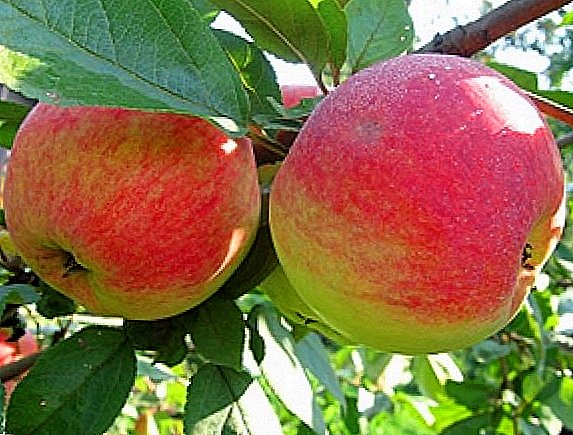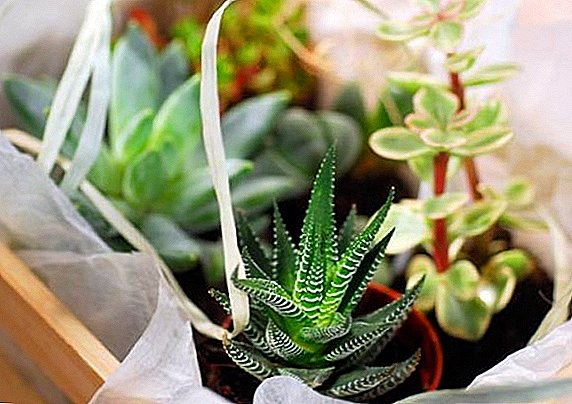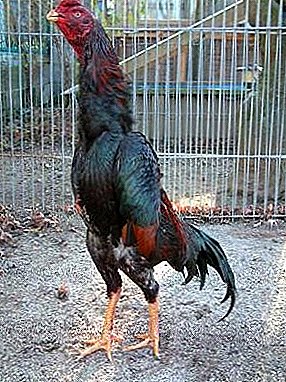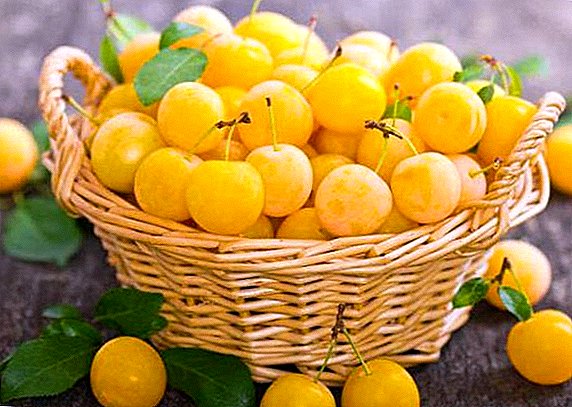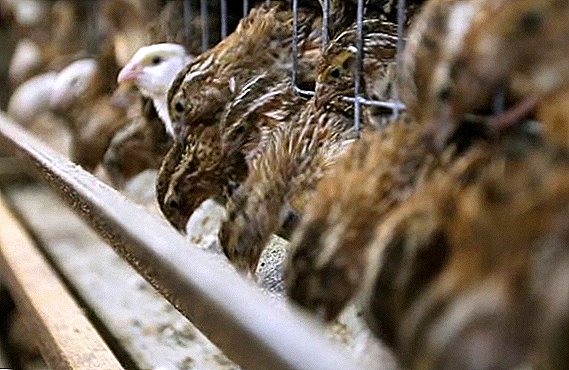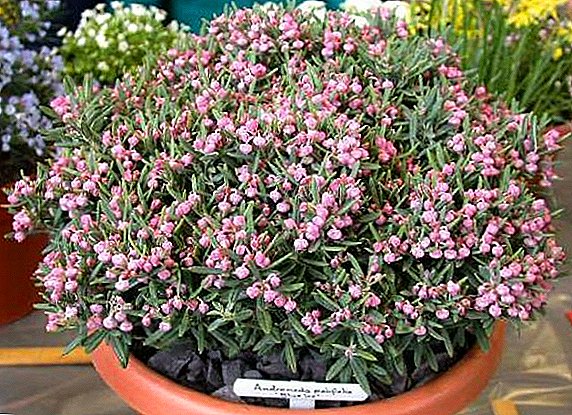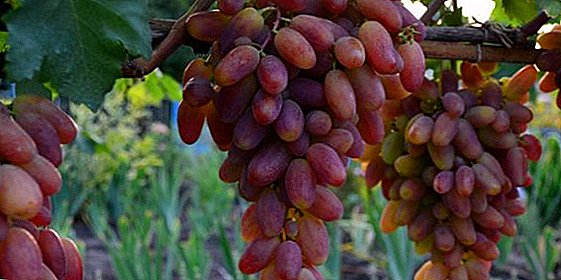 Big clusters of early ripening juicy berries grapes "Transformation" appreciated by many gardeners in the post-Soviet territory. Despite the fact that this hybrid has not yet been included in the State Register, he has already earned popular recognition and has been credited as professional grower in the top ten varieties of culture. What you need to know in order to grow on your site a seedling of a new variety, and how to care for it, read in this article.
Big clusters of early ripening juicy berries grapes "Transformation" appreciated by many gardeners in the post-Soviet territory. Despite the fact that this hybrid has not yet been included in the State Register, he has already earned popular recognition and has been credited as professional grower in the top ten varieties of culture. What you need to know in order to grow on your site a seedling of a new variety, and how to care for it, read in this article.
Did you know? Worldwide, vineyards occupy about 80 thousand square meters. 71% of all plantings are used for winemaking, 27% - for consumption of fresh berries, and only 2% - for the manufacture of raisins. The largest vineyards are famous for Spain (11,750 km²), France (8640 km²), Italy (8270 km²).
History of grapes "Transformation"
Grapes "Transfiguration" is the brainchild of a native breeder and gardener from Novocherkassk Viktor Kraynov and the description has much in common with other varieties of the author - "Victor" and "Anniversary of Novocherkassk."  Find differences in them can only be a professional. In the people, all 3 hybrid forms are called "Troika Krainova".
Find differences in them can only be a professional. In the people, all 3 hybrid forms are called "Troika Krainova".
It is known that the author himself singled out from all the hybrids obtained grapes "Transformation"experiencing feelings of admiration and pride in their creation.
The taste and productivity of his brainchild received recognition from other growers from the regions of southern and temperate climatic latitudes.  Over the 13 years of its existence, the species has taken root well in the farmsteads of residents of Ukraine, Belarus, Russia, Latvia, and Moldova. But unfortunately, still has not received the status of a variety.
Over the 13 years of its existence, the species has taken root well in the farmsteads of residents of Ukraine, Belarus, Russia, Latvia, and Moldova. But unfortunately, still has not received the status of a variety.
What was taken as the maternal basis for creating a hybrid remained a secret; there is only information that the “Transfiguration”, “Victor” and “Novocherkass Anniversary” were descended from one seedling.
Together with grapes on your site will look beautiful currants, honeysuckle, gooseberry, saplings of strawberries, blueberries, yoshta, dogwood.
Biological description and characteristics of the variety
The hybrid belongs to the table top-grape, which is cultivated for consumption in raw form and for the purpose of winemaking.
According to its external characteristics, the variety is distinguished by large pink-yellow fruits of a cylindrical shape with a thin peel covered with a light touch of wax. But if the plant is cultivated in the sun, the grapes usually lose their pink color. In size, one berry reaches almost 4 cm in length and 2,5 - 3 cm wide.
A large cluster contains individual fruits, weighing about 20 g, and their dimensions are beyond 5 cm.
Important! To curb the intensive growth of the vine, gardeners cut off the shoots of 8 eyes.Grape brushes are not dense, acquire a conical shape and weigh about 1 kg on average. Some, especially large, heavier - 3-3.5 kg.
For full ripening, the hybrid will take about 115 days, and in the southern regions you can harvest in the last July week. The fruits have a pronounced sweet taste, slightly sour.
About 20 g of sugar was found in their dense and juicy pulp. With one plant, under favorable cultivation conditions, it is possible to remove 20 kg of berries twice a year. The vine of the grapes "Transformation" is developing rapidly, characterized by moderate resistance to cold and disease.
Easily takes root on any soil, quickly adapts after transplanting. This is a self-pollinating variety, not prone to pea fruit.
Pros and cons varieties
The hybrid form of grapes "Transformation" is not yet fully understood, so there is no official assessment of its positive and negative sides.  Nevertheless, the growers of many countries had their own impression of the cultivation and the fruits of this variety. In the reviews you can hear the following strengths. plant characteristics:
Nevertheless, the growers of many countries had their own impression of the cultivation and the fruits of this variety. In the reviews you can hear the following strengths. plant characteristics:
- early fruit ripening;
- the possibility of harvesting twice a day in July and October;
- good adaptation on stocks of any kind;
- stable fruiting;
- intensive development of bushes, regardless of soil characteristics;
- excellent transportability grape clusters:
- high-quality harvest on the external and taste characteristics.
 Among them are the average frost resistance (when frosts are over -18 ° C, the plant dies) and sensitivity to fungal diseases.
Among them are the average frost resistance (when frosts are over -18 ° C, the plant dies) and sensitivity to fungal diseases.The ability of the vine to be fattened is also noted, therefore the culture requires systematic care.
Did you know? Ukrainians do not eat grapes well. The annual consumption of table varieties of this crop per inhabitant does not even reach one kilogram, moreover, the norm is 8-10 kg.
What to look for when buying seedlings
Planting material is advisable to buy in specialized centers, where the risk of being deceived is minimized.
Making a purchase, remember that the quality of the seedling determines the development of the plant for the next five years, so special attention should be paid to the roots.  They should be different strength, smooth and solid surface, without any growths, curvature, abrasions and other damage of any nature. Also see if there is a seedling frostbitten or putrid plots.
They should be different strength, smooth and solid surface, without any growths, curvature, abrasions and other damage of any nature. Also see if there is a seedling frostbitten or putrid plots.
It is important that the root system is not dry. You can check this by slightly scratching some branching of the rhizome or making an incision.
The fresh wood of green color appeared on the wound site indicates the suitability of the material for planting. From the proposed seedlings, choose one that has strong healthy white color roots.  Among the graft specimens, choose material with a length of up to 45 cm with a rhizome of about half a meter. At each seedling must be at least one 10-centimeter sprout.
Among the graft specimens, choose material with a length of up to 45 cm with a rhizome of about half a meter. At each seedling must be at least one 10-centimeter sprout.
How to plant grapes saplings
The yield of grapes "Transformation" is largely dependent on compliance with the rules of planting.
In order for a bush to grow well, it must be planted in the right place at the right time. Let us understand in more detail the subtleties of rooting the vine.
Timing and site selection
Spring - The optimal period for planting hybrid saplings. Training should be planned in September, and landing - with the onset of stable heat.  To reduce the risks of nematode and fungal diseases of the plant, the earth should warm up well.
To reduce the risks of nematode and fungal diseases of the plant, the earth should warm up well.
Also at this time it is important to plant grafted material. Until the fall, such a bush will grow and strengthen its roots, which will ensure a comfortable wintering for it.
Important! For each bush of the Transformation grape the permissible load is up to 35 buds.
Preparatory work on the site
Preparations for the spring planting of the vine begin well in advance, even in the fall. Ideally, gardeners should, during this period, decide on the location of the shrub and prepare the soil so that it will sink well over the winter.
It is not recommended to do this in the spring, because the substrate will not have time to cope, it forms many lumps and voids, where the roots will be uncomfortable.  A suitable area for the variety "Transformation" will be a place protected from the wind, somewhere near the southern wall of the house or the fence.
A suitable area for the variety "Transformation" will be a place protected from the wind, somewhere near the southern wall of the house or the fence.
When preparing the selected area, you need to make a recess 50 x 50 cm and fill it with the top layer fertile soil.
The lower substrate balls are mixed with equal parts of organic matter (horse manure or chicken droppings can be used) and compost, and also superphosphate granules are added.
In this case, the fertilizer is mixed with organic substances. Then, with a mixture to the top, the dug hole is poured and covered with plastic wrap, securing its edges. Watering the hole is not recommended until the landing.
Seedlings preparation
If the planting material was purchased long before planting, before the very process of rooting, you should re-examine the rhizome and make sure that there are no dead and rotten zones on it.  The bark should be holistic, and the 2 upper eyes - in a good condition. On the grafted seedlings remove small shoots, leaving the longest and most powerful. He is clipped to 5 eyes, and the roots are shortened by 15 cm.
The bark should be holistic, and the 2 upper eyes - in a good condition. On the grafted seedlings remove small shoots, leaving the longest and most powerful. He is clipped to 5 eyes, and the roots are shortened by 15 cm.
After that, the seedlings are placed on the day in the water so that they are saturated with moisture and do not dry.
Some gardeners are advised to add a solution to their capacity that stimulates their growth (for example, "Kornevin" or "Humat"). Bring the workpiece to the landing site should be in a bucket of clay mash.
Important! Fresh pork and melted dung from other animals is not suitable for planting a vine. The fact is that a lot of beetle larvae dwell in it, which, growing up, begin to gnaw a plant.
Stepwise landing process
When planting grape cuttings, the pit prepared from autumn should be re-digged, the rhizome should be lowered into it, straightened, watered and covered with substrate.
At the same time it is necessary to tamp the embankment well in order to fill the voids formed in the roots. Above the ground 2 peepholes should rise, sprinkled with fresh soil on top of them. When rooting grafted seedlings, pay attention to the place of vaccination was not deepened. It should be 3 - 4 cm above the ground.
For mass plantings of vines, observe distance between them in the aisles of 1 - 1.5 meters. In order to facilitate the process, make the markup with a cord and pegs.
After the seedling is in the ground, be sure to water it again and grumble the tree trunk.
This is done in order to ensure the plant effect of the greenhouse and prevent evaporation of moisture. Such a bush will quickly adapt to new conditions and will easily grow.
How to care for grapes
Grapes "Transfiguration" in the care has established itself as not capricious and very grateful variety.  For normal development and generous fruiting, he needs moisture, nutrients in the soil, good haircut, prevention of infection from diseases and attacks of pests. And now about everything in order.
For normal development and generous fruiting, he needs moisture, nutrients in the soil, good haircut, prevention of infection from diseases and attacks of pests. And now about everything in order.
Treatment and protection from pests and diseases
Among the malicious insects who love to feast on the fruits of the grapes, first of all, it is worth to highlight the wasps. They massively flock to the sweet berries and eat holes in them.
Such clusters lose their appearance and deteriorate. You can save them from the invasion of these sweet teeth by removing the wasp nests in the courtyard and in the nearest territory.  Some growers hide brushes in mesh bags or set up special home-made traps from plastic bottles. Be prepared for the fact that the fight with wasps is very time consuming and often inconclusive.
Some growers hide brushes in mesh bags or set up special home-made traps from plastic bottles. Be prepared for the fact that the fight with wasps is very time consuming and often inconclusive.
For the purpose of preventive measures against fungal and bacterial diseases of grapes, experts recommend using solutions of fungicides, Bordeaux mixture (1% concentration).
Insecticides that will save your garden from insects: "Actofit", "Omayt", "Calypso", "Inta-vir", "Fitoverm".Recommended 2 - 3 disinfection for the season. In addition, it is very important to monitor the moderation of the soil moisture, avoiding neither the earthen clod drying out nor its waterlogging.
Did you know? More than 150 active substances and about a dozen vitamins have been found in the grapes. In addition, 100 g of fruit is only 65 Kcal.
Watering and mulching the soil
When watering plants important sense of proportion. Grapes love moisture, but can not grow in the marshland. Therefore, wetting the soil, consider the location of groundwater.  Systematic watering is needed for the bush during the beginning of the growing season and until flowering. Later, when the ovary begins to appear, the procedure should be stopped, resuming watering only during prolonged droughts.
Systematic watering is needed for the bush during the beginning of the growing season and until flowering. Later, when the ovary begins to appear, the procedure should be stopped, resuming watering only during prolonged droughts.
Experienced winegrowers make shovel shallow hole in the circle of the plant to drain excess water.
In order to retain moisture, in the spring and autumn it is necessary to cover the soil around the vine with 3 cm mulch from humus or peat. In summer, the need for such a ball disappears, because it can provoke overheating of the root system.
Fertilization
This factor is key in ensuring abundant fruiting of grapes. In a poor land, a plant will not be able to produce tasty berries in large quantities, and even twice a year.  Therefore, the gardener must make some effort, regularly feeding the culture.
Therefore, the gardener must make some effort, regularly feeding the culture.
Experts do not advise to limit the repetition of mineral complex fertilizing, because the bush has a need for different nutrients that it needs in certain concentrations, depending on the specific stages of development.
In order not to harm the crop, each grower must figure out what, when and why you need to make a vine. For example, nitrogen is responsible for increasing biomass.  On this basis, substances containing this element (urea, ammonium nitrate) are introduced in the spring during the initial phases of the growing season, and such supplements are not practiced in the autumn.
On this basis, substances containing this element (urea, ammonium nitrate) are introduced in the spring during the initial phases of the growing season, and such supplements are not practiced in the autumn.
When the bushes cover the color, they need podzhivit phosphorus. For this purpose, recommended superphosphate, which contributes to the better development of inflorescences, ovaries and the rapid ripening of berries. Potassium is useful for grapewood and grapes.
The use of such fertilizers as: "Crystal", ammophos, potassium sulfate, and "Zircon" will significantly improve the condition of your plants in the garden.His experienced gardeners are advised to contribute in early autumn or in the last summer weeks. The crop's frost resistance will help harden copper, the crop will increase due to zinc, and boric acid will take care of the sugar content in the berries.
Important! The first top dressing of grapes is done in the spring before the bushes are opened after winter, the second - a few weeks before flowering, the third - before the berries ripen, the last - after the harvest.
Literate pruning
Pruning grape stalks should be in the fall or spring before bud break. On the variety "Transformation" practiced fan formation of the vine, in which the cut falls after 6 - 8 peepholes. Permissible no more than 28 shoots per plant. Pay attention to the grapes and during flowering. Given the heavy weight of the brushes, do not overload the vine, leave one bunch on each sprout. 
Shelter for the winter
After feeding the grapes with copper-containing substances, do not relax. After all, they do not guarantee the bush careless wintering.
You must do this. Namely: cut 75% of the vine, remove it from the supports and, bending down to the ground, wrap.  Some gardeners share the experience of sheltering the grape branches with soil and hay, others cover with sacking.
Some gardeners share the experience of sheltering the grape branches with soil and hay, others cover with sacking.
But taking into account the average frost resistance of the hybrid, it is better to take care of reliable protection and to thoroughly grind the soil in the bore circle.



